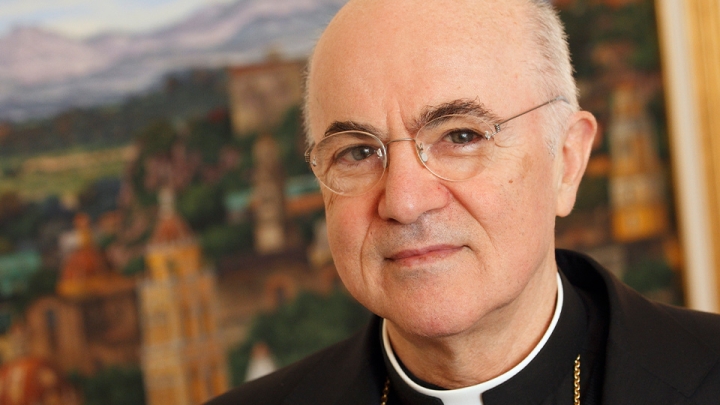
Interview with Monsignor Viganò (part one). “This is how Bergoglio works for schism. And he uses synodality for his own purposes”
Dear friends of Duc in altum, there have been loud reverberations stemming from the interview that Archbishop
Carlo Maria Viganò did with me a few days ago [here], which was translated into several languages. The dialogue offered numerous important points for reflection, especially regarding the strategy pursued by Bergoglio and, as a consequence, the type of response that ought to be offered in defense of the Faith and correct Catholic doctrine. In order to deepen the themes addressed in the interview, we approached Archbishop Viganò again and engaged in a second conversation. We will publish it in two parts.
***
Your Excellency, I think it is appropriate to start our conversation again with what you said responding to my question about the logic followed by Bergoglio in his most recent nomination of cardinals. You said:
Bergoglio’s logic is very evident: he wants to create the premises for a schism, which he denies and deplores in words, but which he has been preparing for some time. Bergoglio wants to separate, in one way or another, the good part of the faithful and clergy from the official Church; and to achieve this, to ensure that they distance themselves from the modernist Sanhedrin, he is placing in key positions in the Roman Curia those characters who guarantee the worst possible management of the Dicasteries entrusted to them, with the worst possible result and the greatest damage to the ecclesial body.
The progressive restrictions on the celebration of the ancient liturgy serve to confine conservatives to hunting reserves, in order to then channel them towards the Society of Saint Pius X, as soon as the Synod leads the doctrinal, moral and disciplinary changes that are in the pipeline to their tragic consequences, causing an exodus of Catholics into what, after the suppression or normalization of the Ecclesia Dei Institutes, will become the “monopolist” of Tradition. But at that point – that is, when the traditional Catholics have migrated into the Society and its leaders believe they have won a victory over the competition due to the suppression of Summorum Pontificum– a new intolerable provocation will force at least one faction of the Society of Saint Pius X to distance themselves from Bergoglian Rome, sanctioning the “excommunication” of traditionalism, which is no longer represented within the official Church, if it ever was. For this reason, in my opinion, it is important to maintain a certain fragmentation, in order to make the malicious maneuver of expelling traditional Catholics from the ecclesial body more complex.
Deaconesses, the abolition of ecclesiastical celibacy, the blessing of homosexual couples, tolerance for polygamy, gender theory, LGBTQ ideology, and ecological pantheism à la Teilhard de Chardin: these are the points of confrontation that Begoglio is deliberately opening up between the conservative wing (but not the traditional wing, which is already distant or out of the picture) and the ultra-progressive one. His purpose is to create confrontation, let it grow, encourage the supporters of the most extreme requests with appointments and promotions, so as to then witness the predictable reaction of condemnation by the few good remaining Bishops, priests and religious, who, in front of Bergoglio’s trap door, will have two choices: either to return to suffer in silence, or or to stand up, denounce the betrayal of Catholic Truth, and be forced to leave one’s post and exercise the ministry clandestinely or at least in apparent canonical irregularity.
Once the inconvenient Pastors have been ostracized and the faithful conservatives have been dismissed, the Bergoglian hierarchy will be able to exercise full control over the clergy and people, certain of the obedience of those who remain. And this sect, which will only have the name of Catholic (and perhaps not even that anymore), will totally eclipse the Bride of the Lamb, in the paradox of a traitorous and corrupt Hierarchy that abuses Christ’s authority to destroy his Church.
In short, the logic seems to be to create conditions that will make true Catholics abandon the Barque of Peter. Is this correct?
Look, already back in 2019 (here) Bergoglio said clearly that he does not fear a schism. And while he stated that “schismatics always have one thing in common, they detach themselves from people, from the faith of the people, from the faith of the people of God,” he added: “The morality of ideology leads you to rigidity, and today we have so many schools of rigidity within the Church, which are not schisms, but they are pseudo-schismatic Christian ways that will end badly: when you see rigid Christians, bishops, and priests, there are problems behind them, there is not the sanity of the Gospel.” As usual, he accused Catholics of doing what he himself was about to do.
In order to further highlight the strategy adopted by Bergoglio, you have mentioned an essay by an American author who already in 2018 highlighted certain lines of action which were soon confirmed. Can you tell us about this essay?
Of course. The author is Patrick Archbold, and his essay appeared in five installments in 2018 at Creative Minority Report, entitled Actuating Schism (here, here, here, here, here).
In this essay, with great lucidity, the author outlines what in his opinion was the malicious action of the Argentine intended to deliberately cause a schism in the heart of the Catholic Church. Archbold wrote:
We can count on this process to continue. Gamed synods producing pre-ordained results to continue to move the heretical ball down the field. […] The Church has been in a de facto state of schism for some time, only that those who no longer hold to the Church’s teachings refused to leave. Now, they are not just here but they are in charge. They didn’t seek their own alternative church or power structure, they instead took the long view and were covetous of the name Catholic and its power structure. They didn’t want their own Church, they wanted ours. Now they have the power and they use power.
Archbold continues:
So this is the question that stays with me. How do you get rid of those Catholics who are fighting against your power? How do you get rid of faithful Catholics who, by definition, tenaciously cling to the one true church? How do you get the true Catholics out of the true Church? How do you turn a de facto schism into a real one?
And here Archbold wisely outlines the scheme adopted by the Central Committee of Santa Marta, identifying it by the consistencies that are detectable in several different cases: the Franciscans of the Immaculate, Bishop Rogelio Livieres Plano in South America, Bishop Martin Holley in the United States, the Petites Sœurs de Marie Mère du Rédempteur in France. To this short list we can add the names of many other Bishops and religious communities – especially communities of religious women – who since 2018 have been given a taste of Bergoglian mercy.
The system is always the same: there is an Apostolic Visitation made with very short notice, no report is ever made about the results, or about any critical issues found, and there is no possibility of clarification or defense for those who are the object of the investigation.
The message and the method is clear. When they want you gone, they can make you gone. They aren’t even going through the motions any more and any and all sense of due process or rights under canon law have been dispensed with. That should make any Bishop nervous, which is exactly the point.
In parallel with this completely illegitimate canonical action, Bergoglio’s emissaries do not hesitate to intimidate the Bishops and communities so as to prevent them from welcoming those who are ostracized: we remember well the way that Father Fidenzio Volpi participated irregularly in the meeting of the Italian Bishops’ Conference in order to carry out an act of terrorism against the Franciscans of the Immaculate, threatening the Episcopate by telling them not to incardinate the conservative friars into their Dioceses.
But when the rules allowed for other Bishops to possibly provide an escape hatch for the abused, those prelates were threatened and the rules were changed to make sure that no bishop could allow new faithful Catholic groups to form in some far flung diocese.
It seems to me that Traditionis Custodes is precisely the expression of this plan…
Exactly. Traditionis Custodes claimed for the Holy See the faculty to canonically erect “traditional” institutes, and it made the Bishops understand that no diocesan priest would obtain permission to celebrate according to the ancient rite. The cancellation of Summorum Pontificum goes in this same direction, this is obvious. It’s enough to think of, among others, the case of the Benedictine Sisters of Pienza or the Dominican Sisters of Marradi who just happen to find themselves in a situation that is no different from the Petites Sœurs de Marie Mère du Rédempteur: “they have committed the double crime of being a little too conservative and of possessing real estate coveted by the local Ordinary” – a property on a hill overlooking the Val d’Orcia or an enormous 16th-century convent in the Appenines. The same thing happened with the Carmel of Arlington, Texas, where the fury against the conservatism of the nuns led to the shameful defaming of the Mother Prioress, who was subjected to a commissioner and dismissed in violation of the canonical norms. There too, it is a Monastery with a vast amount of property and a oil field.
But while the Vatican does not hesitate to limit the rights of Bishops to prevent them from helping certain traditional communities to survive, it significantly extends the rights of other Bishops beyond the law – by sanating the irregularities and abuses of its own lackeys – whenever it serves to suppress and persecute such communities. To this we may add the Constitution Vultum Dei Quærere and the Instruction Cor Orans, with which Bergoglio has deprived monastic communities of their autonomy and arranged them into federations under the strict control of ultra-progressives – along with Chinese-style reprogramming – of the self-styled Dicastery for Religious.
The politburo approved Catholic media will tell you that synodality is all about decentralizing the governance of the Church closer to the people in the form of the Bishop’s conference. This, obviously, could not be further from the truth. In an incredible validation of the lie, before the ink was even dry on the synod document on synodality, the Pope personally intervened to publicly castrate the USCCB before they even thought about even discussing doing something useless about the abuse scandal. It was quite the show, even for veteran Church watchers.
Archbold sums up this pattern with the following words:
It is about making sure that no stray orthodox bishop can be a bastion of tradition and a safe space for traditional Catholicism. He can’t allow new groups of religious to form in his diocese, he can’t invite traditional nuns to set up shop in his diocese, and if he does anything too traditional, he will be on the receiving end of an apostolic visitation for the crime of not getting along with his Bishop’s conference. All of this has been about cutting off all escape paths for traditional Catholics.
At this point Archbold quotes a passage from The Art of War by Sun Tzu: “To a surrounded enemy, you must leave a way of escape.”
Archbold comments:
To surround the enemy, you must cut off all other paths of escape. You need to get the enemy, traditional and red-pilling conservative Catholics, all into one place where they feel safer, before you lower the boom. But the boom. She is coming. […] I believe they intend to do away with Summorum Pontificum and its individual right of priests to say the mass and force all traditional Catholic into one or a few approved sources, perhaps the FSSP and the ICKSP or some juiced up Ecclesia Dei commission, if they can’t close the deal on the SSPX. […] They will move us back to the indult era and consolidate us into a few groups (FSSP, ICKSP, etc) and some grandfathered indult locations. They will claim, and their lickspittle brethren in the mainstream Catholic media will gush, that this is not an anti-Traditional move. “The Pope hasn’t done away with one single Traditional mass, this is about governance only.” […]
So there you have it. Any approved group that resists the changes or complains too loud gets the Apostolic Visitation and is squashed for refusal to submit to the Pontiff. Any diocesan indult community that resists is squashed. And any Catholic who thinks he can go underground and just have masses said in someone’s house? Nope. Individual priests no longer have the right to say the mass. Do it and you have refused to submit to the authority of the Pope. You are a schismatic. So too any bishop. You either accept the Vatican Two boot on your neck or you are a schismatic.
Any attempt to live an authentic traditional Catholic life, whether as a religious, or just attending the mass of the ages, will make you a schismatic by default. Go SSPX, you are schismatic. Go to an underground mass. Schismatic. Form a group of faithful under a traditional rule without permission of Rome, schismatic. They will turn any and all attempts to live a traditional Catholic life into an act of disobedience.
It seems clear that, five years later, the alarm raised by Archbold’s 2018 essay has proven to be well-founded. But as many clerics, religious, and faithful rightly ask, at this point how can we resist this subversive action, if any path we undertake will lead to us being accused of schism?
We find the answer in the firm resistance of those who have preceded us: from the heroism of the Martyrs and Confessors of the Faith to the silent faithfulness of many Catholics – clergy, religious, and laity – who down the centuries have found themselves faced with the same choice: either to choose the broad and comfortable path of compromise and apostasy or the narrow and difficult way of fidelity to Christ. It is a choice that is often painful, but one for which the Lord has prepared us: “Do not think that I have come to bring peace on earth. I have not come to bring peace but a sword. For I have come to separate the son from his father, the daughter from her mother, the daughter-in-law from her mother-in-law: and one’s enemies will be those of his own household. (Mt 10:34-36).
This sword – which Saint Paul identifies with the sword of the Spirit, the Word of God (Eph 6:17) – separates Christ’s faithful from a rebellious and corrupt hierarchy, faithful religious from their heretical Superiors, and faithful priests from their modernist Bishops. And our enemies are those of our own household: our parish priests, the Bishops, and the one who usurps the Throne of Peter in order to spread error and division.
Woe to the world for scandals! Scandals must inevitably occur, but woe to the man through whose fault scandal comes (Mt 18:7). These words admonish us about the seriousness of the present scandals – doctrinal, moral, and liturgical – and about their inevitability, which is the result of the temporary triumph of the wicked before the Final Judgment. But these words also admonish us to resist them, to denounce them, to not consider them to be normal just because they have become widespread at every level of daily life.
Let’s not forget that for sixty years we have become accustomed to seeing the authority of the Pastors used against the faithful and against the Church herself, all while maintaining an appearance of formal legitimacy. The “Council” itself – the only Council that is dear to the heart of the Modernists, because it is the only one of which they are the architects and that has nothing Catholic about it – was a colossal deception against the ecclesial body, because it maintained the authority of an Ecumenical Council while fraudulently insinuating heretical doctrines; it maintained the authority of the Council Fathers and the Roman Pontiff precisely as it was being used to demolish the Catholic edifice; it imposed blind and servile obedience to norms in contrast with the uninterrupted and immutable Magisterium. The abolition of the traditional Liturgy, intended by Paul VI using his apostolic authority, was a fraud. And the current attempt to cancel Benedict XVI’s Motu Proprio Summorum Pontificum with an analagous Motu Proprio – apparently carrying the same canonical efficacy – is no less malicious. Its aim is not the good of the Church and the salvation of the faithful, but the ruin of both. On the other hand, even the accusation of blasphemy that the Sanhedrin brought against Our Lord had all the appearances of a formally unexceptionable action, even though it was intrinsically illegitimate and null, because it was used against the Divine and Innocent Legislator.
Authority can obtain obedience in virtue of its own authoritativeness, or it can impose itself with authoritarianism. In the first case, power is exercised for the purpose for which it has been instituted; in the second case authority becomes the end in itself. Authoritarianism subverts the divine order – both in temporal matters as well as in religious ones – because it prescinds from the sole authority of Christ and from the vicariousness of the earthly authority that represents him. In short, authoritarianism acts as if a person placed in authority – a governor, a Bishop – possesses his own legitimacy in himself, and not because he is a vicar of the authority of Christ. This makes it a subversive power, unchained from any duty to conform itself to the will of Christ in pursuing the common good, and for this reason it is inexorably destined to transform itself into hateful tyranny.
End of the first part



